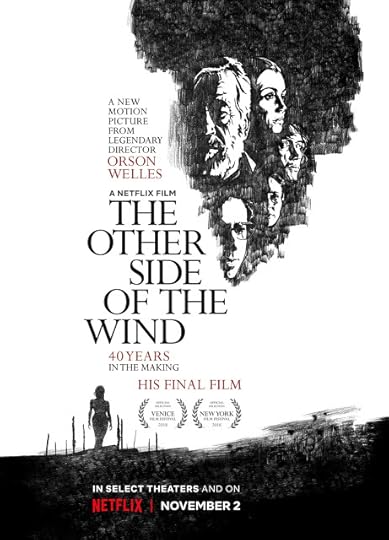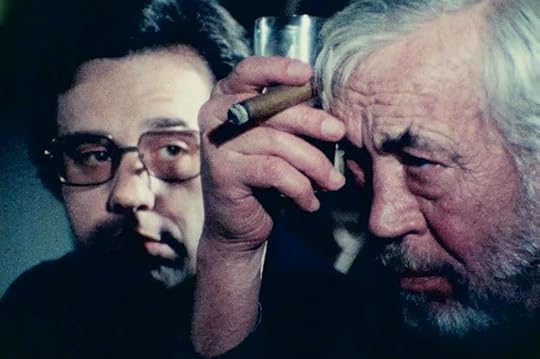Movies I Watched in November, Part 2: 'The Other Side of the Wind'
If any movie deserves its own blog post, it's Orson Welles' final film, right?

Last time, here on the blog, I mentioned how bizarre it was that I was able to watch the brand-new Coen brothers movie on Netflix. That’s nothing compared to how strange it felt to sit down, fire up the app on my TV and watch a legendary film by a legendary director that, until recently, looked like it might never, ever see the light of day.
Orson Welles spent years filming “The Other Side of the Wind” in bits and pieces, changing the cast, tweaking the plot (or at least the basic concepts – this isn’t exactly a plot-heavy film) and working behind the scenes to dig up whatever financing he could. When he died in 1985, the film was still (a) unfinished and (b) mired in legal tangles that would doom a lesser film to eternity in a vault. But in 2017, to virtually everyone’s astonishment, Netflix threw $5 million at the project; got everyone to play nice; and had the original negative, dailies and other footage shipped to Los Angeles where it was finally assembled, scored, finalized and shown to a select audience, including Quentin Tarantino, Paul Thomas Anderson and Crispin Glover. And now, assuming you have Netflix, you can watch it, too. Right now. At this moment. Just by pressing a button.
So, how is it?
First off, there’s no possible way "The Other Side of the Wind" could live up to the legend it's accumulated over the decades, both thanks to Welles' involvement and the fact that film fans assumed they’d never get to see it. There’s just too much mythology, mystery and controversy make any sort of level-headed evaluation possible. It’s like what Chuck Klosterman said about the Guns N’ Roses album “Chinese Democracy” when it finally arrived in stores: “Reviewing ‘Chinese Democracy’ is not like reviewing music. It’s more like reviewing a unicorn. Should I be primarily blown away that it exists at all?”
Well, as far as “The Other Side of the Wind” goes, its existence alone is pretty impressive. But you know what? So is the movie itself. Conceived by Welles as a reaction to the art films of the era (the late ‘60s and early ‘70s), “The Other Side of the Wind” depicts the last day in the life of Jake Hannaford (John Huston), an aging (but legendary) director working on a troubled art film. (Not at all autobiographical, obviously.) The film cuts between a party for Hannaford and the film-within-a-film (also titled “The Other Side of the Wind”), is a plotless but visually stunning collection of scenes/shots mostly involving a mysterious woman (Oja Kodar, Welles’ longtime mistress and creative partner) and the James Dean-like star (Robert Random) who has a strange hold over Hannaford.
It’s a bit of a mess, to be honest, but it's a fascinating mess, with the sensory overload of the party scenes (overlapping conversations, pointless digressions and frenetic editing) balancing nicely with the relative peace and calm of the artsy fartsy stuff. Welles claimed those scenes were a parody of filmmakers like Antonioni, but truth is, they’re beautiful and compelling all by themselves. Welles still had the touch in his mid-50s, and the more permissive era gave him the chance to try things he'd never done before -- like, for instance shoot a mesmerizing sex scene that he couldn't have included in “Citizen Kane.” For me, the highlight of "The Other Side of the Wind" is an elaborate sequence set in a restroom that equals just about anything from the era when it was made – or from our current era, for that matter. It reminds you how great Welles could be when he was excited about a project – and he was clearly excited about “The Other Side of the Wind.” Why else devote so much time and energy to getting it made?

The film’s also fascinating as an artifact, collecting performances by people who never shared the screen before and definitely would never do so again. Huston is great, of course, and Welles was right to cast an actual legendary director as his fictional legendary director. I love Welles as an actor (see the blog post on “Chimes at Midnight” coming up soon), but Huston works better than Welles would have here, serving as the (relatively) calm center of all this chaos. Hannaford dies on the night the movie takes place (not a spoiler – just like in “Kane,” Welles reveals his main character’s fate in the opening seconds of the film), but unlike Welles, Huston still had some great films ahead of him: “Prizzi’s Honor,” “The Dead” and my personal favorite, “The Man Who Would be King.” Weird to think he and Welles made their directing debut the same year (1941) and delivered two classics that still stand the test of time (“Kane” and “The Maltese Falcon”). The difference? One of them knew how to play the (studio) game, the other didn’t – or at least refused to.
The rest of the cast is a who’s who for movie nerds (like, ahem, the guy writing this blog post). Peter Bogdanovich essentially plays himself, a critic-turned Hannaford acolyte-turned successful director. (His role originally went to, believe it or not, Rich Little, who still shows up in some of the party scenes.) Other Welles’ pals in “The Other Side of the Wind” include Mercedes McCambridge (“Touch of Evil”), Paul Stewart (“Kane”) and Orson’s old, somewhat shattered buddy Edmund O’Brien. Party guests include Dennis Hopper, Cameron Mitchell, Stafford Repp (Commissioner Gordon from the “Batman” TV show!), Gregory Sierra (Julio from “Sanford & Son”!), Angelo Rossitto (from “Freaks” and “Mad Max: Beyond Thunderdome”!) director Cameron Crowe, disgraced CBS chief Les Moonves and many, many more. It’s chaos, to be sure, but what successful party – or successful movie -- isn’t a little chaotic?
“The Other Side of the Wind” isn’t a great film. Given all the delays, heartbreak and budget battles that went into its production, editing and release, maybe it never had a shot at true greatness. But it is a film – the last film, in fact -- from a great director, one who was trying to do something exciting and different – and, yes, something great – against some pretty overwhelming odds. Since his early days, when he was staging groundbreaking plays in New York and conjuring up fake Martians in New Jersey, Welles always seemed more interested in the process than the result, and if the end result of “The Other Side of the Wind” isn’t what he dreamed of (and everyone hoped for), it’s still an entertaining, challenging, fascinating artifact, one where the troubles – and thrills – of the production shine through in every frame.
The fact that Welles never got to see the final film is a tragedy, but the fact that you and I can see it, right now, is some sort of miracle.
Published on December 07, 2018 17:10
No comments have been added yet.
Will Pfeifer's Blog
- Will Pfeifer's profile
- 23 followers
Will Pfeifer isn't a Goodreads Author
(yet),
but they
do have a blog,
so here are some recent posts imported from
their feed.



